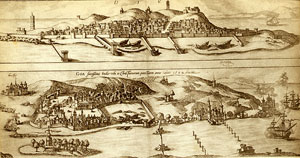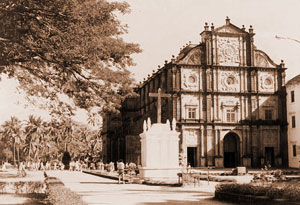|
|
History of Goa
..........................................................................................
|
|
Early Goa
Goa has a long and chequered history. Some identify it
in the Mahabharata as Gomant, Where Vishnu, reincarnated
as Parasurama, shot an arrow from the Western Ghats into
the Arabian Sea and with the help of the god of the sea
reclaimed the beautiful land of Gomant. Siva is also
supposed to |
 |
|
|
have stayed
in Goa on a visit to bless seven great sages who had performed
penance for seven million years. In the Puranas the small
enclave of low lying land enclosed by the Ghats is referred to
as Govapuri, Gove and Gomant. The ancient Hindu city of Goa
was built as the southernmost point of the island. The jungle
has taken over the virtually nothing survives.
Contact with the Muslim World
Arabian geographers knew it as Sindabur. It was ruled by the
Kadamba dynasty from the 2nd century AD to 1312 and by Muslim
invaders from 1312 to 1367. It was then annexed by the Hindu
kingdom of Vijayanagar and later conquered by the Bahmani
dynasty of Bidar in Northern Karnataka who founded Old Goa in
1440. It had already become an important centre for the trade
in horses with the Vijayanagar Empire. When the Portuguese
arrived, Tusuf Adil Shah, the Muslim king of Bijaipur, was the
ruler. At this time Goa was an important starting point for
Mecca bound pilgrims, as well as continuing to be a centre for
the import of Arab horses and as a major market on the West
coast of India.
The Portuguese arrival
The Portuguese in their quest for control of the lucrative
spice trade from the East Indies, were intent of setting up a
string of coastal stations from the home country to the Far
East. Goa was the first Portuguese possession in Asia and was
taken by Alfonso de Alburquerque in March 1510, the city
surrendering without a struggle. Three month later Yusif Adil
Shah blockaded it with 60,000 men. In November Albuquerque
returned with reinforcements, recaptured the city after a
bloody struggle, massacred all the Muslims and appointed a
Hindu as Governor.
The Portuguese rarely interfered with local customs except for
forbidding the burning of widow (sati). At first they employed
Hindu as officials and troops. Mutual hostility towards
Muslims encouraged cordiality and trade links between Goa and
the Hindu kingdom of Vijayanagar. Religion only became an
issue in later years when missionary activity in India
increased. Franciscans, Dominicans and Jesuits arrived,
carrying with them both religious zeal and intolerance. The
Inquisition was introduced in 1540. |
|
|
|
Goa as
capital
Goa became the capital of the Portuguese empire in the
East and was granted the same civic privileges as
Lisbon. It reached its greatest splendour between 1575
and 1600, to decline when the Dutch with their superior
seafaring skill began to control trade in the Indian
Ocean. The fall of the Vijayanagar empire in 1565 caused
the lucrative trade between Goa and the Hindu state to
dry up. The Dutch blockaded Goa in |
 |
|
|
1603 and
1639. They weakened but did not succeed in taking it. To add
to its woes, it was ravaged by an epidemic in 1635. Manpower
was severely depleted and the Portuguese were forced to bring
criminals from their Lisbon prisons to maintain their numbers.
Distracted by the Mughals in 1683, the Marathas called off
their attack on Goa which remained safe in its isolation,
though it was threatened again briefly in 1739. The seat of
government was shifted first to Margao and then in 1759 to
Panaji mainly because of outbreaks of cholera. Over this
period (1695 to 1775) the population of Old Goa dwindled from
20000, to 1600 and by the mid 19th century only a few priests
and nuns remained.
Independence
The Portuguese came under increasing pressure in 1948 and 1949
to cede their territories of Goa, Daman and Diu to India. In
1955 satyagrahis (non violent demonstrators) attempted to
enter Goa, who were deported but later when larger numbers
tried, the Portuguese used force to repel them. The problem
festered on until the Indian Army supported by a naval
blockade marched in in 1961 and brought to an end four and a
half centuries of Portuguese rule. This act certainly
tarnished then Prime Minister Jawaharlal Nehru’s international
reputation but it did mean that all land in India was Indian.
Today Goa has one of India’s highest per-capita incomes, with
farming, fishing, tourism and iron-ore mining forming the
basis of its economy. |
|